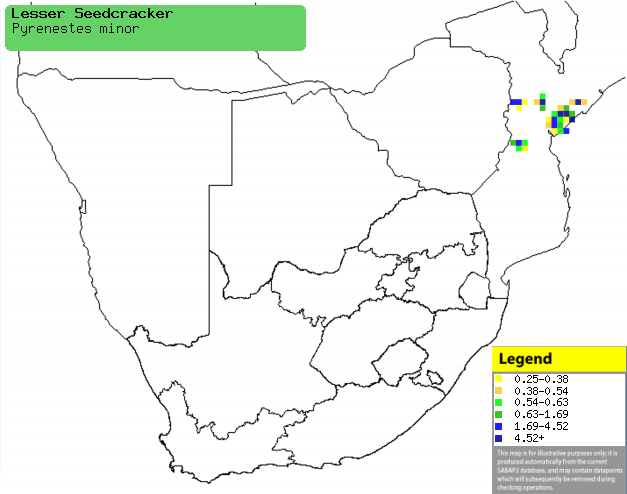|
Pyrenestes minor (Lesser
seedcracker, Nyasa seedcracker)
Oostelike saadbrekertjie [Afrikaans];
Rooistertsaadvretertjie [Afrikaans]; Granta-astrild [Dutch]; Petit
pyréneste [French]; Kleiner purpurastrild [German]; Quebra-sementes do
Niassa [Portuguese]
Life
> Eukaryotes >
Opisthokonta
> Metazoa (animals) >
Bilateria >
Deuterostomia > Chordata >
Craniata > Vertebrata (vertebrates) > Gnathostomata (jawed
vertebrates) > Teleostomi (teleost fish) > Osteichthyes (bony fish) > Class:
Sarcopterygii (lobe-finned
fish) > Stegocephalia (terrestrial
vertebrates) > Tetrapoda
(four-legged vertebrates) > Reptiliomorpha > Amniota >
Reptilia (reptiles) >
Romeriida > Diapsida > Archosauromorpha > Archosauria >
Dinosauria
(dinosaurs) > Saurischia > Theropoda (bipedal predatory dinosaurs) >
Coelurosauria > Maniraptora >Aves
(birds) > Order: Passeriformes
> Family: Estrildidae
Distribution and habitat
Occurs from southern Tanzania through southern Malawi to
northern and central Mozambique, marginally extending into eastern Zimbabwe. It
generally prefers tangled undergrowth with patches of rank grass, especially
along streams or surrounding wetlands but also in miombo (Brachystegia)
woodland and on the forest edge.
|
 |
|
Distribution of Lesser seedcracker in southern Africa,
based on statistical smoothing of the records from first SA Bird Atlas
Project (©
Animal Demography unit, University of
Cape Town; smoothing by Birgit Erni and Francesca Little). Colours range
from dark blue (most common) through to yellow (least common). |
Predators and parasites
Its eggs are sometimes eaten by
Laniarius
aethiopicus (Tropical boubou).
Food
It mainly eats grass seeds, probably supplemented with
insects. Its bill size varies considerably from 10-16mm long, indicating that
some birds can eat harder seeds while others cannot. The following food items
have been recorded in its diet:
- Seeds
- Olyra latifolia (forest grass)
- Arthropods (eaten in captivity)
Breeding
- The nest is mainly built by the male, consisting of an untidy oval with a
short entrance tunnel on one side, made of broad strips of grass, reeds and
banana leaves. It is typically placed in a fork of a tree or bush,
approximately 1.5-3.0 metres above ground.
- Egg-laying season is from December-May.
- It lays about 3 eggs, which are incubated by both sexes for about 15
days.
- In captivity, the chicks leave the nest after about 20-23 days.
Threats
Not threatened.
References
-
Hockey PAR, Dean WRJ and Ryan PG 2005. Roberts - Birds of
southern Africa, VIIth ed. The Trustees of the John Voelcker Bird Book
Fund, Cape Town.
|
